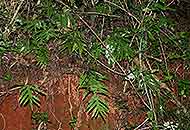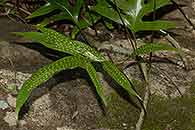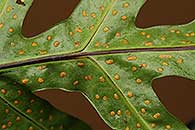Microsorum scolopendria (Burm. f.) Copel.
Synonyms |
Phymatodes scolopendria (Burm. f.) Ching |
|---|---|
Common name |
|
Description |
Rhizome widely creeping, up to 1 cm in diameter; rhizome scales up to 4 mm long, dark brown, (narrowly) lanceolate in outline, apex tapering to a point, finely toothed, later lost and surface becoming white. Fronds widely spaced, coriaceous, glabrous. Stipe up to 45 cm long, stramineous to light brown, glabrous. Lamina up to 60 × 30 cm, deltate-ovate to broadly oblong in outline, deeply pinnatifid into 4-8 pairs of lobes and a terminal segment. Lobes up to 22 × 3 cm, narrower in fertile than in sterile fronds, narrowly oblong to linear in outline, apex pointed, margins entire to somewhat wavy, glabrous. Sori round to oval, 2-3 mm in diameter, in 1-2 regular to irregular lines on either side of the costae, slightly sunken into the lamina, prominent on the upper side, exindusiate, with nonpeltate paraphyses. |
Notes | |
Derivation | skolopendrion: a millipede; a comparison alluding to the creeping rhizome with its rootlets. |
Habitat | Evergreen forest and thicket, Brachystegia woodland, mangrove swamps edges, limestone cliffs, oil palms, mango, clove trees and Pandanus. |
Distribution worldwide | Africa, Comoro and Mascarene islands, Madagascar, Seychelles, Sri Lanka, southeastern Asia, Indo-China, Malaysia to Australia and Polynesia. |
Distribution in Africa |
Angola, Benin, Cameroon, Central African Republic, Dem. Republic of Congo, Equatorial Guinea (incl. Bioko), Ethiopia, Gabon, Ghana, Guinea, Ivory Coast, Kenya, Liberia, Mozambique, Nigeria, Sierra Leone, South Africa, Sudan and South Sudan, Tanzania , Togo, Uganda, Zimbabwe. |
Growth form |
Epiphytic, lithophytic, terrestrial. |
Literature |
|





